Arachnophobia (the fear of spiders) affects around 5% of the population including celebrities as diverse as Justin Timberlake and JK Rowling. Whilst both statistically and factually there is very little to fear from most spiders these little eight-legged critters do seem to have reserved a special place in the human psyche.
It is true that all spiders, by their definition, posses a pair of fangs through which they inject venom. And it probably doesn’t help their cause that they feed by turning their prey’s insides to liquid and then sucking it up.
However, it is also the case that only a tiny fraction of the more than 40,000 species of spider pose any real danger to humans. For starters most are too small to be able to puncture the skin and the vast majority are not in the least aggressive. Even those spiders that can bite rarely cause injuries worse than a mosquito bite. It is estimated that during the whole 20th century spiders were responsible for in the region of only 100 deaths globally.
That said, we are now going to look at those spiders that are considered dangerous to humans and have proven capable of inflicting significant injury. If you have seen our list of the deadliest Australian spiders you will be familiar with several of these already although the deadliest spider of them all is not from Australia at all.
10. Hobo Spider (Tegenaria agrestis)
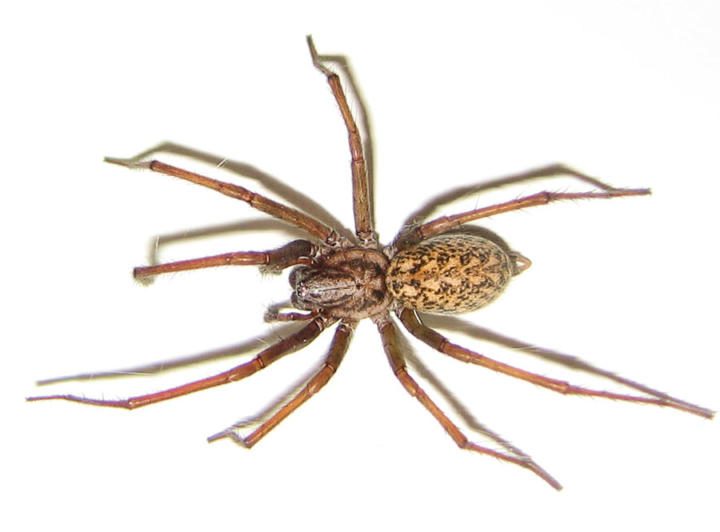
The actual danger the hobo spider presents to humans is somewhat debatable. It has been proven to deliver quite serious bites to lab animals and there are many alleged cases of bites from these spiders causing necrosis, similar, but less severe than that observed in brown recluse bites. These bites cause an open wound which may take many weeks to heal.
There are two reasons the hobo spider has made it onto this list; firstly it is aggressive and fairly common, which increases the chance of an actual bite occurring. In fact the hobo spider is sometimes referred to as the ‘aggressive house spider’, although this could stem from a misinterpretation of its Latin name T. agrestis.
The other reason I’ve included this spider on the list is just because it is quite interesting that this spider only recently arrived in North America. Previously it was common throughout Europe and went practically unnoticed. Where it differs is that in Europe the hobo spider is not found in houses – other bigger, meaner house spiders keep it out!
9. Camel Spider (Solifugae)
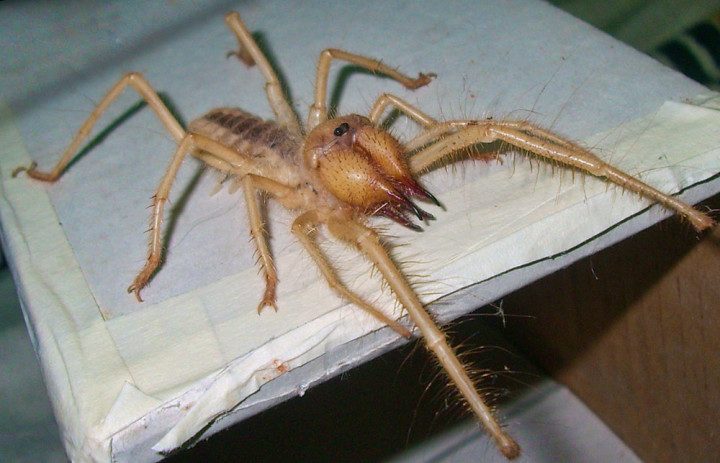
The camel spider really is the stuff of nightmares. The biggest is the Egyptian giant solpugid with a body reaching up to six inches (15cm) in length and powerful jaws making up about a quarter of that this would be one of the biggest, scariest looking spiders in the world, except for one thing – it isn’t a spider, or a camel for that matter. Camel spiders are in fact a type of arachnid known as solifuges, which literally translates as ‘flee from the sun’. Also known as wind scorpions and sun spiders, solifuges are found in deserts throughout the world.
So why is the camel spider in the list at all? Well basically just because they look so fierce and grow so big. They are also lightning fast and capable of running at speeds of up to 10 mph (16 kph). Solifuges can inflict a painful bite but they are not venomous. So those stories about them crawling under camels, disemboweling camels and eating the insides might just be a little bit of an exaggeration!
8. Yellow Sac Spider (Cheiracanthium)
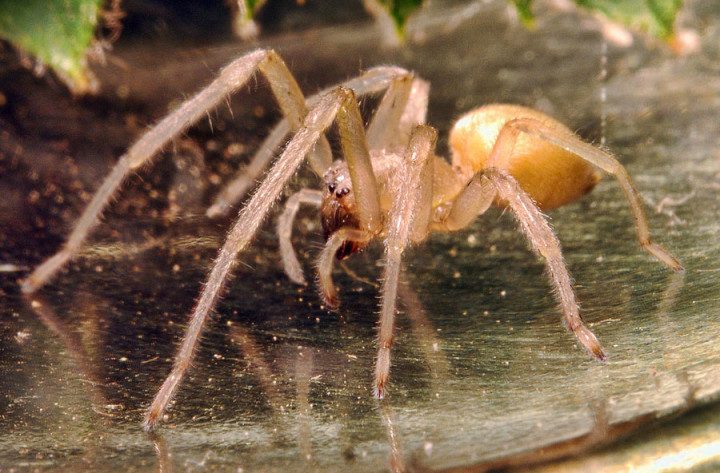
Small and innocuous in appearance but capable of delivering quite a nasty bite, the yellow sac spider is one to avoid. The spiders of the Cheiracanthium family are usually between 5 and 10mm (1/4 to 3/8 ins) long and are pale yellow or green in colour. They are fairly widespread occurring from Australia to Canada and many places in between.
The venom of the yellow sac spider is a cytotoxin, which means it breaks down cells, possibly causing necrosis. Bites are characterized by an initial stinging pain followed by redness and swelling which can develop into a blister or sore. The bite is often compared to that of the brown recluse, although it is less severe and any resulting wound is likely to heal much faster. Some experts reckon that many recorded brown recluse bites are in fact sac spider bites and that these spiders are responsible for more bites than any other species.
7. Fringed Ornamental Tarantula (Poecilotheria)
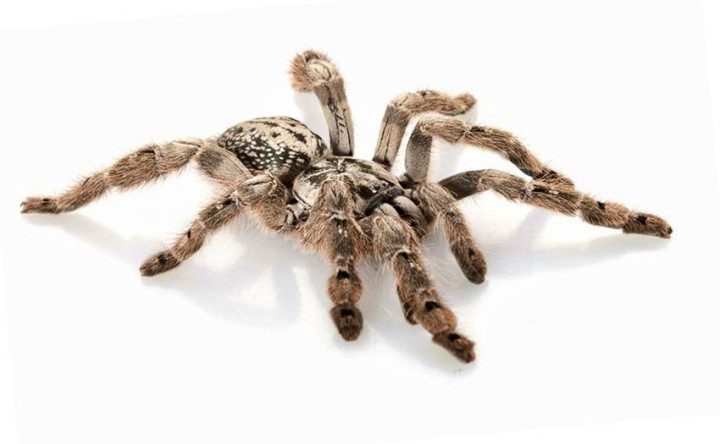
Tarantulas – the archetypal big hairy spiders that have been the terror of arachnophobes since time began. The name comes from a Spanish dance, which apparently is how people jumped around when bitten by one of these critters. Unlike the smaller spiders on this list tarantulas are mygalomorphs, which means their twin fangs point downwards and have to be stabbed into the prey, rather than the pincer like action of most smaller species.
But everybody knows that despite their terrifying demeanor, tarantula bites aren’t so bad, right? Well it may be true that most tarantula bites are no worse than a bee sting, however the Poecilotheria genus of spiders are renown for having a particularly nasty bite, none more so than Poecilotheria ornata – the fringed ornamental tarantula. The bite from one of these is reported to have caused excruciating pain, and extreme muscle cramping in some cases. One bite victim ended up in the emergency room after experiencing severe spasm and chest pains.
So whilst there have been no confirmed fatalities from this tarantula it certainly carries a potent venom and injects it by the bucket load.
6. Mouse Spider (Missulena)
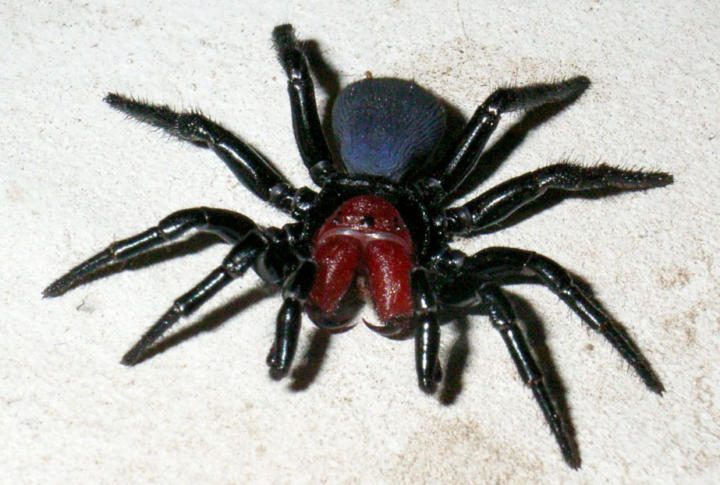
At this point we encounter our first Australian spider and the bites become that bit more medically significant. There are around 12 species of mouse spider in Australia and there name comes from their soft furry abdomens and not from the fact they might eat mice, although I’m sure they would. Armed with huge fangs and a venom that is similar to that of the deadly Sydney funnel-web spider this spider is every bit as dangerous as it looks.
Whilst the mouse spider is potentially dangerous it is far less aggressive than the Sydney funnel-web plus it often gives ‘dry bites’, i.e. without venom. Therefore it appears lower on this list than its meaner cousin.
5. Six-eyed Sand Spider (Sicarius hahni)
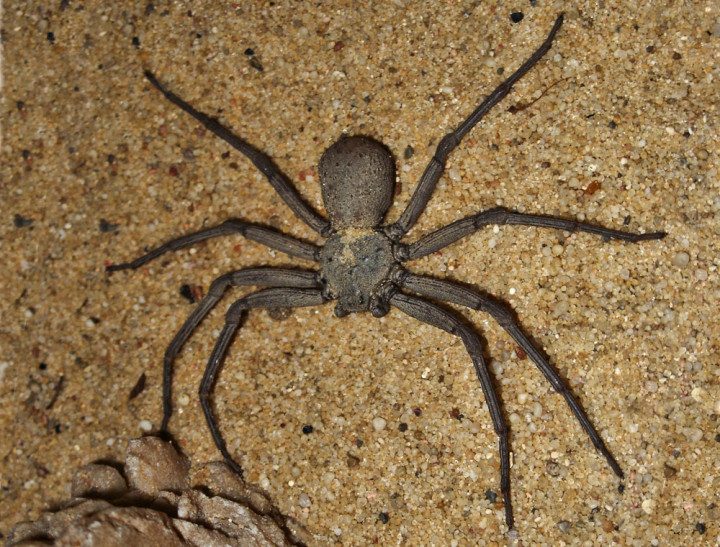
What’s got eight legs, six eyes and lives in the deserts of Southern Africa?! That’s right, the six-eyed sand spider.
The scientific name for this spider’s family is Sicarius which means ‘murderer’ and the spider is certainly an assassin. It hunts by burying itself in the sand and waiting for its unsuspecting victim to wander by at which point it pounces. In trials it was shown that the venom from a bite was fatal to rabbits in as little as 5 hours.
Like their close relatives, the recluse spiders, the venom of the six-eyed sand spider is a powerful cytotoxin. In the case of Sicarius the venom is both hemolytic and necrotic meaning it causes blood vessels to leak and destruction of flesh.
But how dangerous is this spider to humans? Well we aren’t quite sure; there have only ever been two suspected cases of bites to humans and neither were conclusively attributed to the six-eye. Combined with the fact it can survive for a year on one meal it probably isn’t the biggest threat to humans.
4. Redback / Black Widow Spider (Latrodectus)
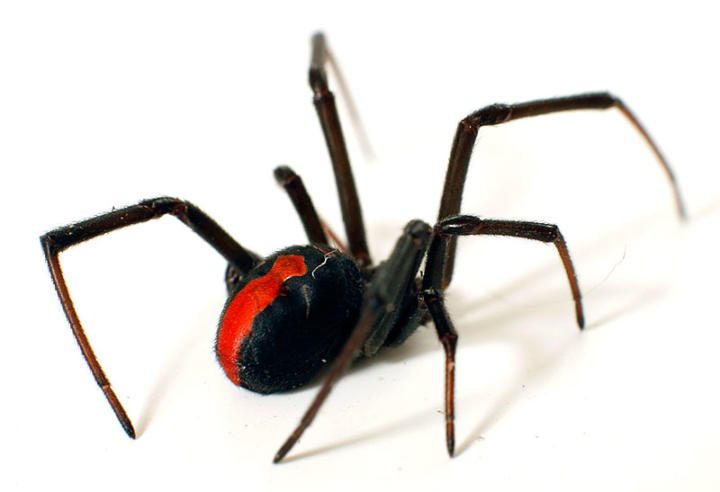
The black widow spider, or redback as it is known in Australia is one of the most iconic spiders on the planet. Instantly recognisable by its round black abdomen with striking red markings these are definitely spiders not to be trifled with. Both the redback and the black widow are from the Latrodectus family with the redback being marginally more venomous than the black widow. And that venom is potent, more so than any other spider but one. The only reason these spiders don’t top the list is because they are smaller and deliver less of it.
The effects of this lethal toxin range from burning pain to a systemic condition known as latrodectism. Symptoms include general pain and swelling spreading from the affected area, abdominal cramps, nausea and sweating to name a few. This condition occurs in around half of bites and was often fatal in the very old and young before anti venom became available.
3. Brown Recluse / Chilean Recluse (Loxosceles)
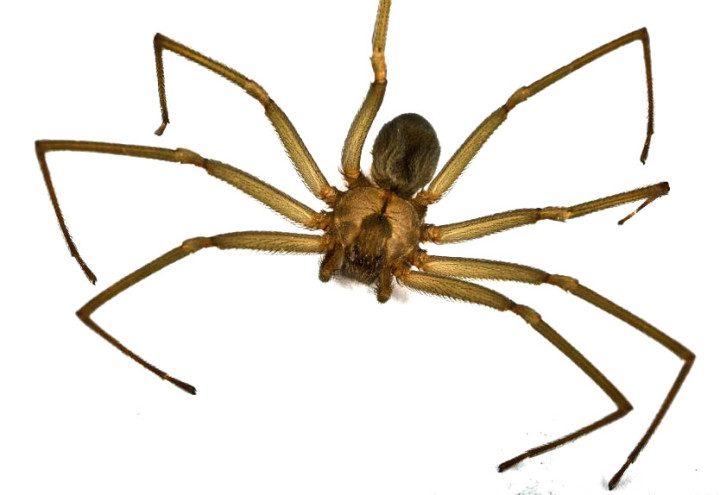
The recluse spiders occur in warmer climes throughout the world. Also known as violin spiders, fiddle-backs or even reapers these six-eyed spiders all possess tissue destroying venom and belong to the Loxosceles family.
Recluse spiders have garnered quite a reputation for themselves over recent years and the internet is awash with some pretty ugly photos of the effects of their bite. The venom of this group of spiders is known to be necrotic, i.e. flesh-eating and whilst usually mild, can result in a condition known as Loxoscelism. In these severe cases the area around the bite begins to die and a deep open sore is formed. There is no effective treatment for these bite wounds and they may take months to heal, sometimes requiring skin grafts.
In the very worse cases limbs have needed to be amputated and there have been a significant number of fatal bites, particularly from the Chilean recluse.
On a more positive note, the recluse is so called as it is relatively shy and not regarded as aggressive. Their small fangs also make it less likely they will deliver a significant dose of venom.
However, think twice before spraying them with a dose of bug-killer; it is reported that they are immune to some insecticides and only make them more toxic and angry!
2. Sydney funnel web (Atrax robustus)
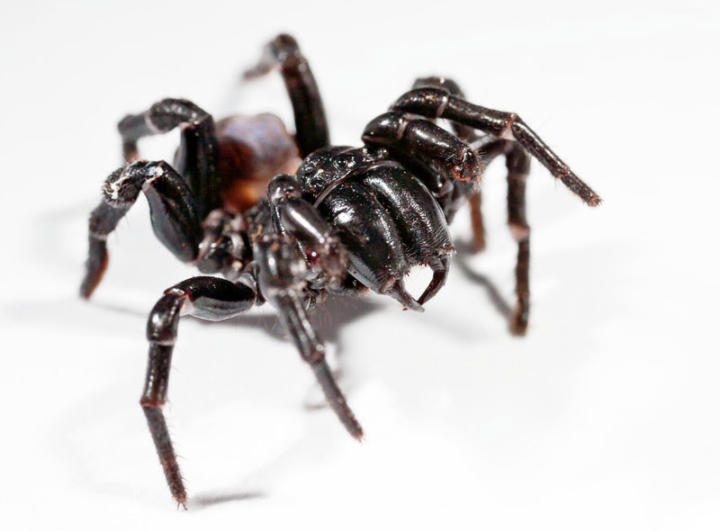
The Sydney funnel-web spider (Atrax robustus) is a veritable bruiser amongst the spider world. Whilst most spiders seek to avoid confrontation with humans the funnel-web will charge in delivering a volley of bites whilst clinging to its victim. So although its venom is no more potent than many of the spiders on this list, the funnel-web makes sure the unfortunate recipient gets the full dose.
In addition to its temperament the Sydney funnel-web is well equipped for the job. It has the most impressive fangs of any spider; these needle sharp weapons are longer than those of some snakes. Armed with these killer fangs and powerfully built, the funnel web is reputed to be able to bite through shoe leather and even finger nails.
Unlike virtually every other group of spiders it is the male Sydney funnel-web that is equipped with the most potent venom – up to six times stronger than that of the female. The venom itself is a neurotoxin which appears to be particularly effective against primates. Within minutes of being bitten the victim may suffer extreme symptoms such as muscle spasms, palpitations, vomiting, confusion and swelling of the brain. In some cases death has followed in as little as 15 minutes after the bite occurred.
The good news is an effective anti-venom was introduced in 1981 and there hasn’t been a death since.
1. Brazilian Wandering Spider (Phoneutria)
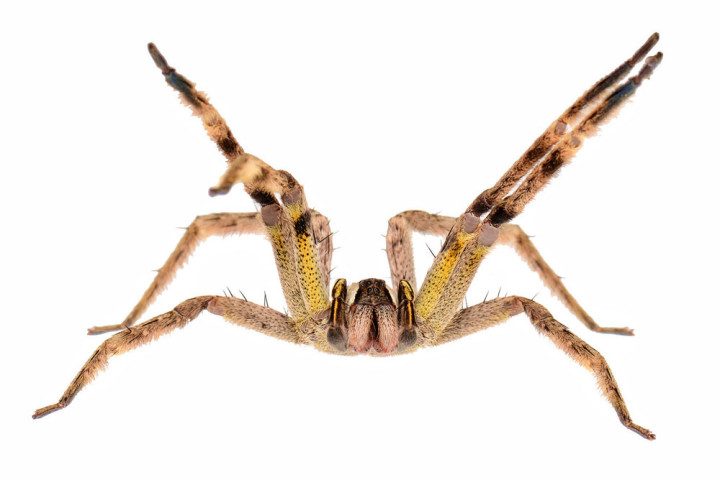
When a spider’s scientific name is derived from the Greek for murderess (Phoneutria) you can guess it’s going to be trouble and this is certainly the case for the wandering spiders. According to Guinness World Records the Brazilian wandering spider (Phoneutria fera) is officially the world’s most venomous spider. It is capable of injecting a powerful neurotoxin which is nearly 20 times more deadly that that of the Black Widow spider if it gets into the blood stream. That is as potent as the venom of many deadly snake species and the effects are similar. The symptoms of envenomation include a loss of muscle control leading to breathing problems which can result in complete respiratory paralysis and eventually asphyxiation.
But there are two other major side effects to the wandering spider’s bite; firstly there is intense pain and secondly, if you happen to be male there is the four hour hard on. Yes, you did read that correctly – the bite of the Brazilian wandering spider can cause an erection that lasts for several hours, unfortunately it is also painful.
In addition to the this deadly venom the behaviour of the wandering spider make it particularly dangerous to humans. As its name suggests the spiders are not confined to a web in a dark corner. In fact they like to turn up in all manner of hiding places; boots, piles of clothes, log piles, cars and bunches of bananas. Also known as ‘banana spiders’ wandering spiders have been known to hitch a ride across the globe in boxes of bananas. In one case a man in the UK was bitten after buying bananas in his local supermarket.
There is little doubt that these are dangerous spiders. Their aggressive nature and close contact with humans have resulted in a number of deaths over the years. In one tragic case a single spider was responsible for the deaths of two children in São Paulo. Fortunately an effective antivenom has been developed and there have been relatively few fatalities since.
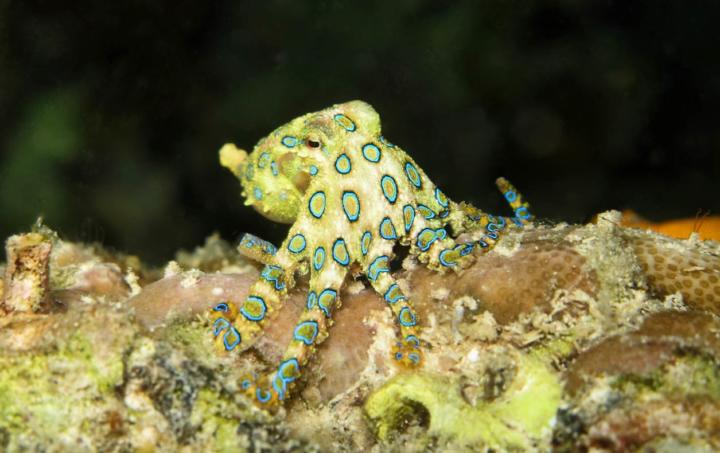

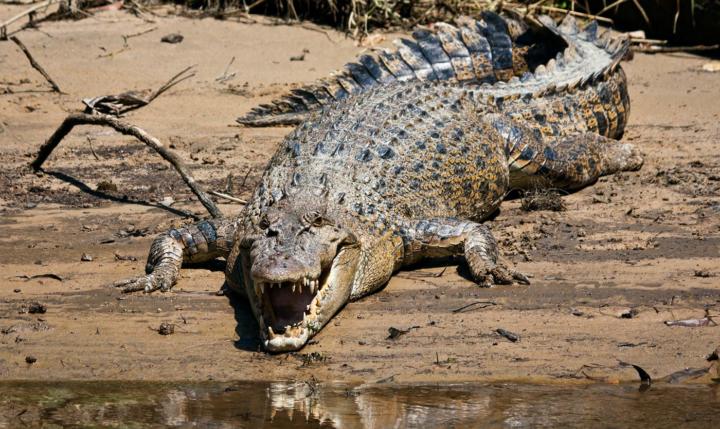
Good list, but Black Widow Spiders and Redback Spiders are two different species.
Yes, but both members of the genus lactrodectus. Or perhaps I should say all members of latrodectus, as there are several widow species.
What makes the redback particularly nasty is that it actually does hide in outside dunnies.
They tend to hang around water: taps and outside toilets. I’m probably within six feet of one or more of them now.
Yes, they’re closely related, but they are not the same species. To say they are the same and just known by different names in different places is inaccurate. For example, the black widow is a fair bit larger and more aggressive, more likely to bite.
The Redback is Latrodectus hasselti, the black widow is Latrodectus mactans.. So there is no, “yes, but” for you to make here. The person who wrote the article is wrong, the person you are replying to is right. They are not the same spider. Same genus, different species.
I live in Oklahoma and brown recluse spiders are common in this area. My grandpa got bitten by a full grown female . When you are in basements or in attics make sure you wear shoes.
For that minority of people (It seems like a majority so many people I come across in some form fear them) that have arachnophobia, treat wasps as your best friend as they are prolific predators of spiders. Or at least they use them as living nurseries for their larvae! Anycase they limit the number of spiders a little, you know they’re dangerous when you see a big tarantula running away from a wasp! So don’t be quick to kill a wasp on sight.
Take care. That is all one has to do. Spiders have their place in nature. Give them their space. Wear protective gear when in the open, especially proper shoes
I’m seeing people handle them without gloves in media, surely that’s reckless yet they insist if you are calm and don’t startle them even black widows etc are very unlikely to bite you. Still if it were me I’d never hold a dangerous creature without gloves on. As for proper shoes that’s definitely not an issue for me I despise open toed shoes by default and when I went on safari in Kenya it is instructed not to wear such shoes anyway, many things out there can bite you so why expose yourself further? Of course there are dangerous creatures that can still bite through a good shoe but still, you’ve limited the chances of being bitten and harassed by being sensible. Needless to say a hot place is NOT short of bugs!
One wonders about tribal people and our ancestors that didn’t wear shoes and clothes, how many died to dangerous bug bites? Snakes still kill a large number of people.
I live in Wollongong Australia and the Sydney Funnel Web is very common to this area.unfortuntly I was bitten by a fully pregnant female in 1988 after putting on a work boot it crawled into.luckly anti-venom is available and it saved my life.So if you travel t or shore be aware of this spider as it is now the 2nd deadliest on the planet.
I told my Mom abut this and she said I spent too much time on the web.
Witty!
We need spiders to keep insect/small rodent populations under control, its the circle of life!
Primarily the invertebrates, the rodents are largely taken care of by cats, snakes etc. It’s a pity spiders aren’t more proactive in limiting mosquitoes!
Come on people there are much worse that walk amongst us.
Yes centipedes are scarier but the worst bug of all’s the mosquito, if you look at the deaths attributed to malaria it’s no contest! People are caught up by sensationalism thanks to movies like Jaws etc distracting them to real life and the real dangers. Spider venom is nowhere as potent as many people think, not to say you shouldn’t be cautious of being bitten by anything though.
Anyhow arachnophobia is such an irrational fear but then I’m a rational person, phobias are lost on me.
I swear to God that I do not care about the natura consequences if I could press a bottom and delete all the spiders (and maybe other insects) in the worlds I would do that, regardless of the fact that humanity might be die in short time.
I am more afraid than spiders than I am afraid of death.
Totally agree. Kindred spirit. Can’t even look at the pictures.
If you did that, the ecosystem would collapse
I scoff at people with arachnophobia, it’s so irrational if you study the facts. I can forgive people being afraid of sharks or snakes, spiders are so small! I think centipedes are far worse anyway than spiders. Worst of all’s the mosquito anyway thanks to it spreading malaria.
The world would collapse without bugs they are a necessary evil somewhat.
You’re definitely missing some impartiality here. Many phobias are based upon common sense, but the phobic person has this fear in great excess. That said snakes aren’t scary, and no-one has ever found a shark in their bed, bathroom, kitchen, shoes, clothing, fresh produce, garden, workshop, workplace, car, motorbike helmet, hair, or ear.
Sharks are dangerous in exactly one place, snakes are easily avoidable.
Spiders are not.
I’d let you press my bottom.